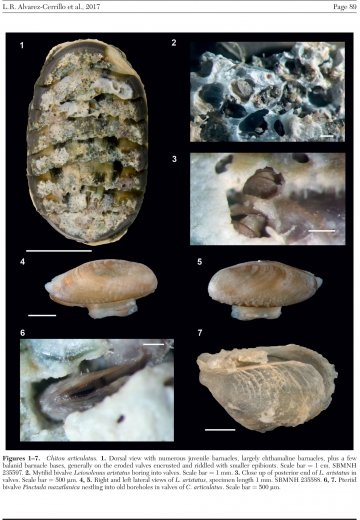A remarkable infestation of epibionts and endobionts of an edible chiton (Polyplacophora: Chitonidae) from the Mexican tropical Pacific
Although epibiosis is common in polyplacophorans, we describe an unusual presence of epibionts and endobionts in a single adult specimen of Chiton articulatus collected in Guerrero, Mexico, from an eroded habitat of crevices with high wave activity. The epibiont and endobiont specimens covered nearly 90% of the central and lateral areas of the chiton valves while the border of mantle girdle showed no epibiosis. Crustose and filamentous algae, and crustacean arthropods from two common barnacle families, Chthamalidae and Balanidae, represent the observed epibionts. Polychaete (Annelida), bivalve mollusks from two families: Pteriidae (Pinctada mazatlanica) and Mytilidae (Leiosolenus aristatus), and crustacean arthropods from the burrowing barnacle family Cryptophialidae (Cryptophialus wainwrighti) represent the observed endobionts. In addition, finding of Cryptophialus wainwrighti represents a new geographic range extension from the type locality in Sinaloa to Guerrero. Epibiosis studies of invertebrates in the intertidal rocky shore, such as the dominant C. articulatus, can assist in understanding ecological relationships and patterns of diversity in coastal communities.



